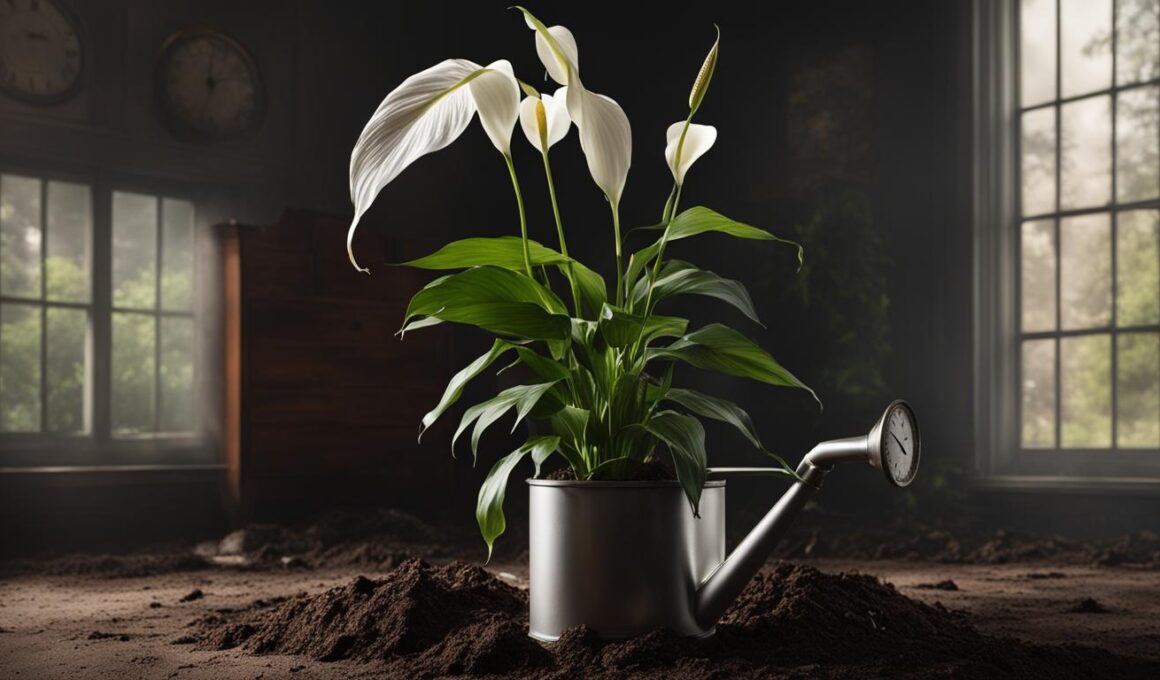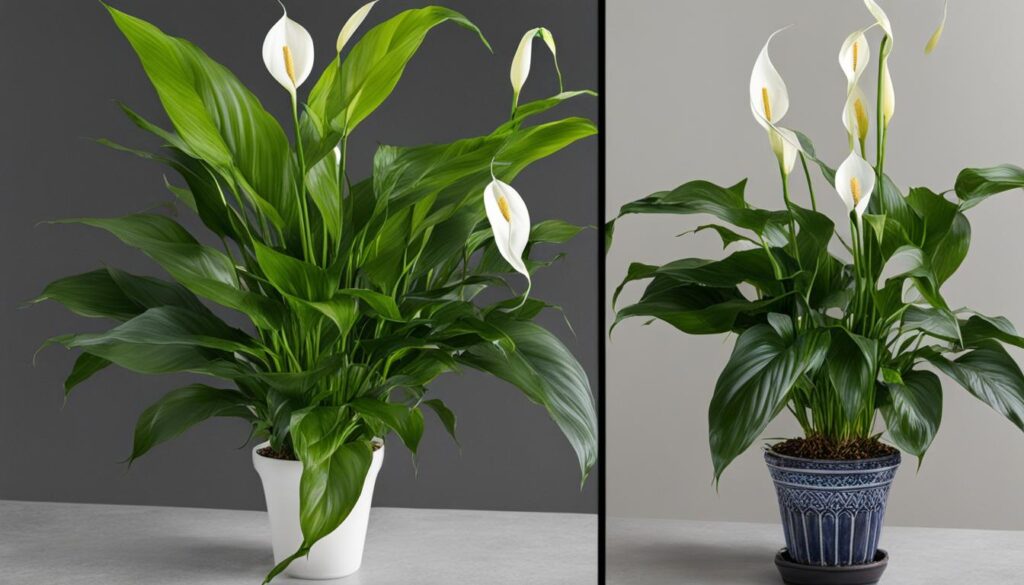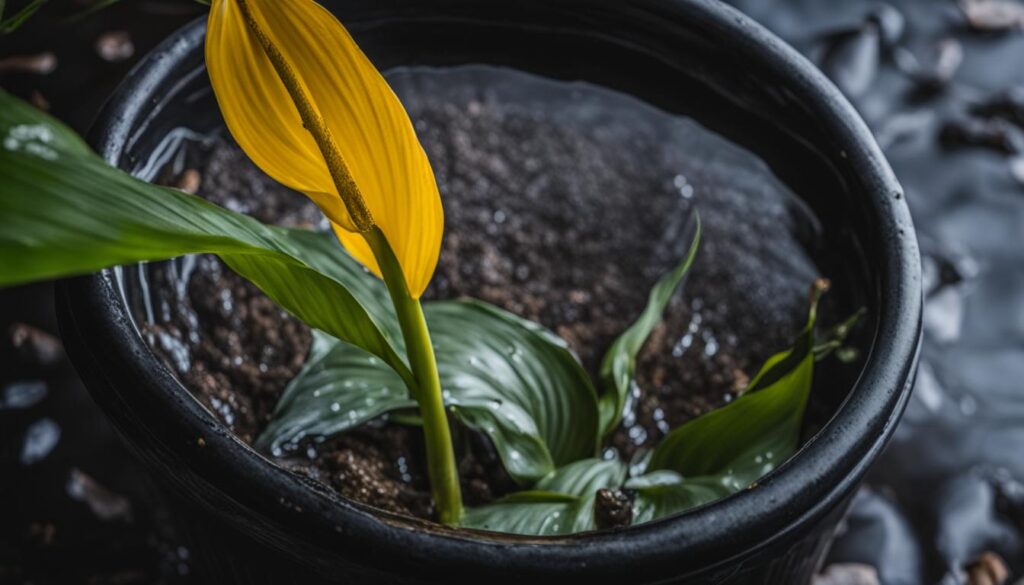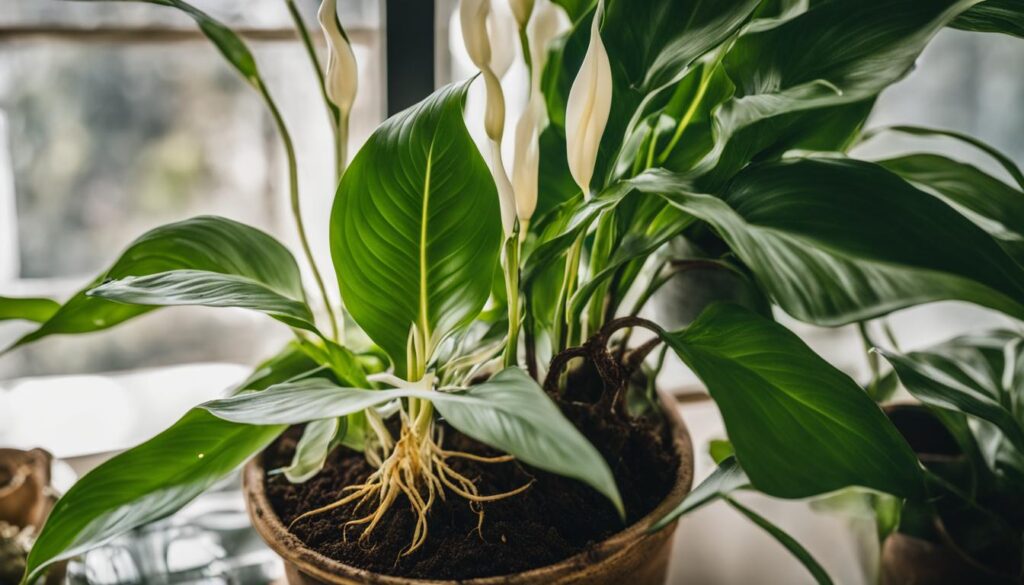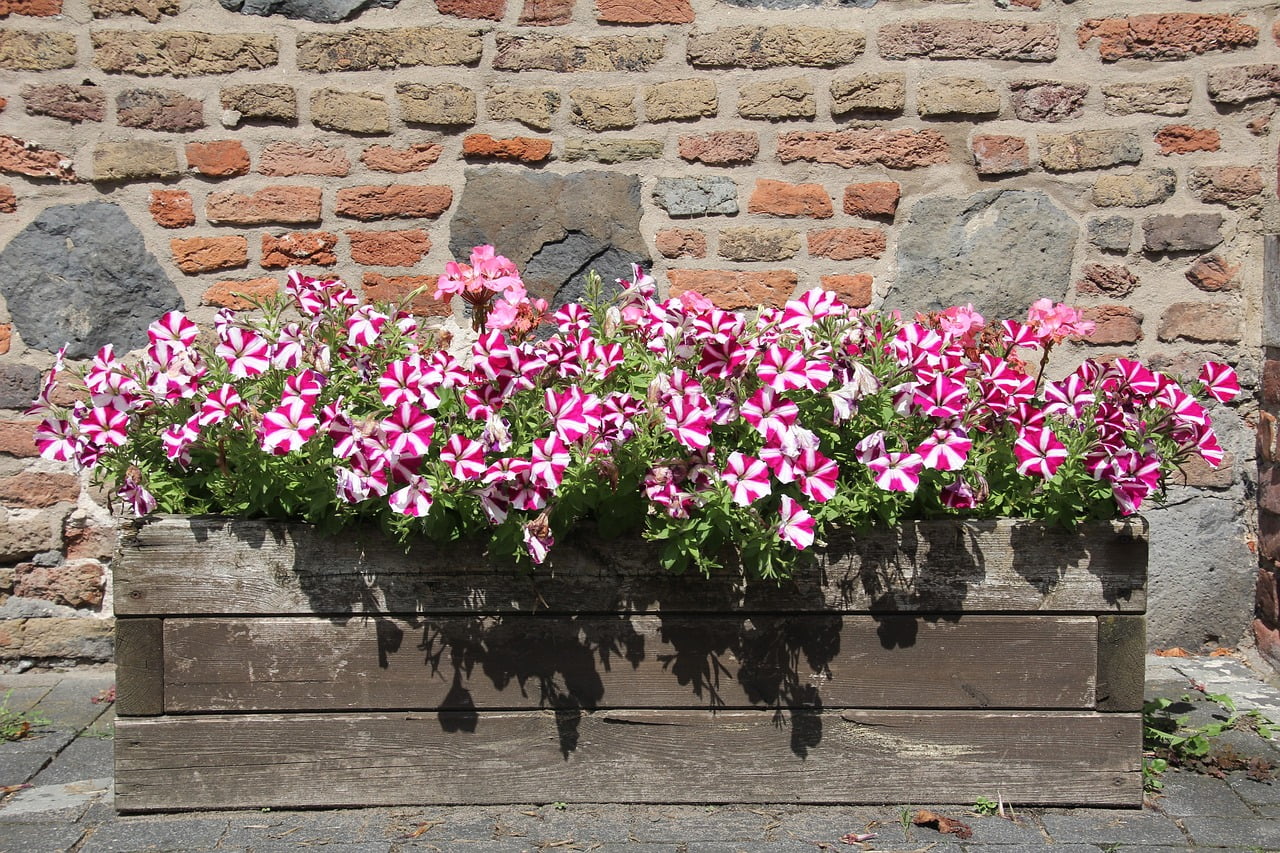Peace lilies are popular houseplants known for their elegant, dark green foliage, and beautiful white blooms. However, they can be sensitive to watering issues, making it essential to understand the signs of an underwatered and overwatered peace lily. Monitoring your peace lily’s soil moisture, pot heaviness, and leaf discoloration will help you identify underwatering or overwatering problems, ultimately guiding you on how to revive the plant by addressing peace lily root rot and other common issues. With proper peace lily plant care, your elegant houseplant will flourish, adding beauty and charm to your home.
Key Takeaways
- Underwatering and overwatering can lead to similar symptoms in peace lilies, such as wilting and leaf discoloration.
- Checking the moisture level of the soil is crucial for identifying whether your peace lily requires more or less water.
- Addressing watering problems promptly helps prevent root rot and other detrimental effects on the plant’s health.
- Reviving a peace lily requires proper trimming, treatment, and repotting in a fresh potting mix with adequate drainage.
- Maintaining an ideal environment, including proper light exposure and appropriate humidity levels, is essential for peace lily plant care.
Introduction to Peace Lily Water Requirements
Proper watering is crucial for peace lily health, taking into account factors like season, light, temperature, humidity, potting mix, and container size. Overwatering symptoms may be confused with those of underwatering due to similarities like wilting and discoloration, hence the importance of checking the soil’s moisture along with observing symptoms. Soil that clings to the skin signals overwatering, while parched soil points to underwatering. A cycle of watering that corresponds to the plant’s needs rather than a fixed schedule can help maintain the right moisture levels, ensuring healthy growth and blooming.
To achieve optimal hydration for peace lilies, it is essential to understand their unique water requirements. Utilizing these peace lily care tips will help in maintaining moisture levels for your plant to thrive. Consider the following factors when watering your peace lily:
- Season: Water more frequently during the growing season (spring and summer) and less during the dormant season (fall and winter).
- Light: Place your peace lily in a location with indirect, bright light. This allows it to photosynthesize efficiently and maintain appropriate water usage.
- Temperature: Keep your peace lily in a room with a temperature range of 65-85°F (18-29°C). Cooler temperatures will slow down the rate at which the plant uses water.
- Humidity: As a tropical plant, peace lilies prefer higher humidity levels. Keeping the humidity around 40-50% will prevent the leaves from becoming dry and crispy.
- Potting mix: Use a well-draining potting mix to prevent waterlogging and ensure proper aeration for the roots.
- Container size: Ensure that the pot is not too large or too small for your peace lily, as this can affect water retention and drainage. Ideally, it should have drainage holes to avoid water stagnation.
Monitoring the soil’s moisture and adjusting your watering practices in accordance with the plant’s needs will result in a healthier peace lily. Utilize the below guidance:
| Watering Indicator | Condition | Action |
|---|---|---|
| Moist soil clinging to skin | Overwatering | Reduce watering frequency |
| Parched soil | Underwatering | Increase watering frequency |
| Moist soil at top 1-2 inches | Optimal hydration | Water as necessary |
By understanding your peace lily water needs, you can properly maintain its moisture levels, promoting a more robust, flourishing plant. Take note of the various factors affecting hydration and continuously assess the soil to ensure your peace lily remains vibrant and healthy.
Recognizing the Signs of an Underwatered Peace Lily
An underwatered peace lily exhibits a few telltale signs that can help you diagnose the problem and take corrective action. Among them are droopy leaves, yellowing or browning leaves, and a wilt-and-water cycle. Let’s dive into these symptoms and better understand how to properly monitor and hydrate your peace lily.
The Telltale Droop: What Limp Leaves Signal
The most noticeable sign of an underwatered peace lily is drooping or limp leaves. When the soil is too dry, peace lilies struggle to maintain their structure and overall health, leading to leaves that appear wilted. Upon watering, the peace lily should quickly perk up, displaying a noticeable improvement in leaf firmness and turgidity.
Color Cues: Yellowing and Browning Leaves
Another classic sign of underwatering in peace lilies is yellow or brown leaves. Failing to provide your plant with adequate water can lead to leaf discoloration, which might be accompanied by a dry, crispy texture. However, it is crucial to distinguish between underwatering and other issues, such as sunscald or pests, which can cause similar symptoms.
Shall We Dance: The Wilt-and-Water Cycle
The peace lily wilt cycle refers to fluctuations in plant health caused by a pattern of wilting and subsequent overcompensation with watering. To break this cycle, regularly monitor your peace lily’s hydration, paying close attention to its behavior, such as drooping leaves indicating the need for water. By responding to these signs in a timely manner, you can maintain consistent soil moisture and promote your plant’s overall well-being.
| Underwatered Peace Lily Symptoms | Actions to Take |
|---|---|
| Drooping or limp leaves | Check soil moisture and water when the top inch of the soil is dry |
| Yellow or brown leaves | Ensure the cause is not sunscald or pests, and water as necessary |
| Wilt-and-water cycle | Adopt a more responsive approach to watering and monitor hydration regularly |
By watching for these underwatered peace lily symptoms and taking appropriate action, you can ensure your plant receives the proper care and watering it needs to thrive.
Understanding Overwatering Symptoms in Peace Lilies
It’s not uncommon to encounter peace lily overwatering problems due to the misconception that these tropical plants thrive in constantly damp conditions. In reality, excessive watering can lead to root rot and a host of other issues. Knowing the early warning signs of an overwatered peace lily is the first step towards restoring its health and ensuring proper overwatered peace lily care.
Initial symptoms of overwatering might be subtle, but paying close attention to your peace lily can help you detect problems early on. Here are some common indicators of overwatering:
- Yellowing lower leaves
- Drooping or wilted leaves with moist soil
- Black or brown splotches appearing on the leaves
- Potting mix remaining moist for several days after watering
- Mushy stem base
- Moldy smell from the soil or pot
In order to prevent overwatering, it’s essential to monitor your plant’s water needs closely. The peace lily thrives in consistently moist but not soggy soil. Adjust your watering habits according to changes in environmental conditions such as humidity, temperature, and light exposure. Additionally, ensure your peace lily is planted in a pot with proper drainage holes, so excess water can escape.
When dealing with peace lily overwatering problems, prompt action is necessary to restore the plant’s health. The following table illustrates some effective measures for overwatered peace lily care:
| Action | Description |
|---|---|
| Trim affected leaves | Prune any yellowed or damaged leaves using clean, sharp scissors. This encourages new growth and helps the plant recover more quickly. |
| Check and improve drainage | Inspect the pot for proper drainage holes, and ensure the potting mix is well-draining. A mix that retains too much moisture can exacerbate overwatering issues. |
| Adjust watering routine | Monitor the soil moisture more closely and water according to the plant’s needs rather than on a fixed schedule. Wait until the top inch of the soil feels dry before watering. |
| Temporarily reduce light exposure | Move the overwatered peace lily to a shadier location until its health improves. This reduces the plant’s water needs and allows for a more gradual recovery. |
Overwatering can have grave consequences for your peace lily’s health. By paying close attention to the early warning signs and taking appropriate corrective measures, you can help your plant recuperate and thrive in the long run.
Consequences of Incorrect Watering: Root Rot and Plant Health
Improper watering of your peace lily can lead to severe health issues, such as root rot. Root rot is often caused by a lack of oxygen due to overwatering, which weakens the roots and makes the plant vulnerable to soilborne pathogens. Detecting peace lily root rot can be done through both a sniff test and visual inspection, allowing for early intervention and prevention of further decay.
Sniff Test: Detecting Rot Before It’s Too Late
To determine if your peace lily is suffering from root rot, a simple sniff test can be useful. If you notice a foul smell emanating from the potting mix, this is one of the prominent signs of root rot. It is vital to address the issue promptly to save your plant and restore its overall health.
Visual Inspection: Discoloration and Texture of Roots
Along with the sniff test, conducting a visual inspection of the plant’s roots can also help identify the presence of root rot. Healthy roots will have a pale hue and firm texture, while unhealthy roots affected by rot will appear brown or black and feel mushy. Regular peace lily root inspections can help you intervene early on and prevent the progression of decay.
Here are some key differences between healthy and unhealthy peace lily roots:
| Healthy Roots | Unhealthy Roots |
|---|---|
| Pale hue | Brown or black color |
| Firm texture | Mushy texture |
| No foul smell | Foul smell |
Keeping a close eye on your peace lily root health through sniff tests and visual inspections is vital in maintaining your plant’s overall health. By catching any signs of root rot early on, you can take the necessary steps to save your plant and ensure its long-term well-being.
Corrective Measures: Rescuing Your Peace Lily
If your peace lily is suffering from overwatering or root rot, don’t worry! There are steps you can take to save it. In this section, we’ll show you how to rescue your beloved peace lily by treating an overwatered peace lily and conducting peace lily root trimming to revive the plant.
Trimming and Treatment: Steps to Revive a Struggling Plant
Follow these simple steps to save your peace lily:
- Remove the peace lily from its container by gently loosening the soil around the roots and lifting it out.
- Examine the roots and foliage for damage. Unhealthy roots may appear brown or black and mushy, whereas healthy ones should be pale and firm.
- Using sterilized scissors, trim away any affected roots or foliage. This will help prevent the spread of disease and improve the plant’s chances of recovery.
- Choose a clean container with adequate drainage holes to ensure the peace lily won’t be sitting in excess water.
- Fill the container with a fresh, well-draining potting mix, ensuring it can provide proper support and nutrients for your peace lily.
- Repot the peace lily, placing it in the center of the container and filling in any gaps with potting mix. Ensure the mix surrounds the roots and covers them, pressing it down gently to eliminate air pockets.
- Water the peace lily thoroughly after repotting, allowing excess water to drain out of the container.
- Monitor your peace lily’s progress, checking the soil moisture regularly and adjusting your watering habits accordingly.
Incorporating these steps into your peace lily care routine can help you rescue and revive a struggling plant. Over time, with proper care, your peace lily should regain its health and showcase its beautiful foliage once again.
Preventative Strategies: Proper Watering Techniques for Peace Lilies
Guaranteeing the proper care of your peace lily starts with understanding their ideal watering requirements. By monitoring soil moisture and facilitating a suitable environment, you can prevent both under and overwatering issues. Utilize the following techniques to maintain your peace lily’s health.
Moisture Monitoring: Touch and Sight Approaches
An effective way to ensure proper peace lily soil moisture is frequently checking the soil’s dampness using touch and sight. A simple finger test involves inserting your finger about an inch into the potting mix to evaluate the soil’s moisture level. Another option is using a moisture meter, which can provide a more precise reading. By employing these methods, you will understand how to water peace lily plants accordingly.
Creating an Ideal Environment for Your Peace Lily
Developing a healthy peace lily environment includes:
- Providing bright, indirect light
- Watering using room temperature water
- Maintaining humidity levels between 40% and 50%
- Avoiding direct sunlight exposure
Implementing these peace lily watering techniques and environmental adjustments promote ideal peace lily care and aid in cultivating peace lilies.
By proactively monitoring soil moisture and creating an optimal environment for your peace lily, you can prevent the common issues of overwatering and underwatering. Meticulous care and attention will help ensure that your peace lily thrives, providing lush foliage and beautiful blooms.
What are the Signs of a Peace Lily Being Underwatered or Overwatered, and How Can I Apply This to My Terrarium?
The signs of a peace lily being underwatered include yellowing leaves and wilting, while overwatering can cause brown spots or rotting roots. To apply this to your terrarium, monitor the watering frequency for terrariums carefully and adjust based on the signs of the peace lily’s water needs.
Conclusion
Peace lily plant maintenance is crucial for ensuring the health and longevity of your plant. Proper care involves finding the right balance between under and overwatering, as well as understanding the unique signs and symptoms that indicate your peace lily may be experiencing watering issues. By following apeace lily watering guide and paying close attention to the specific needs of your plant, you can avoid the complications that arise from over or underwatering.
Regular assessments of your peace lily’s soil moisture, leaf appearance, and overall health will enable you to make timely adjustments to its care routine. Creating an ideal environment for your peace lily, including proper light exposure, room temperature watering, and maintaining appropriate humidity levels, is instrumental in avoiding watering problems.
By taking a proactive and informed approach to the care and maintenance of your peace lily, you can not only avoid common watering issues but also help your plant thrive. Following these guidelines will ensure that your peace lily remains a beautiful and healthy addition to your home for years to come.





